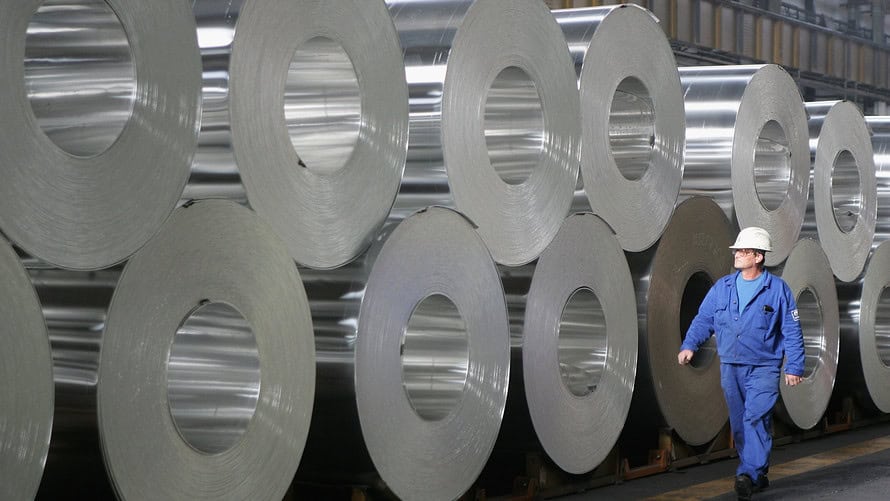
New sanctions on Russia, which include the nation’s aluminum giant United Co. Rusal, have fueled a rally in prices for aluminum, and benefited shares of the metal’s North American producers. Analysts, however, say the pop in prices won’t last much longer than the rift with Russia, which is tough to predict.
In any event, processors and end users of aluminum are expected to suffer the most as the full impact of the sanctions settle in.
The U.S. Treasury on April 6 issued new sanctions on Russian entities and individuals in response to what it said was Moscow’s attempt to “subvert Western democracies” and its pursuit of “malicious cyberactivities.” The sanctions include Rusal, which is responsible for 7% of the world’s aluminum production. Shares of the company traded in Hong Kong 0486, -6.85% fell roughly 56% for the week following the announcement.
On Friday morning, April 13, cash settlement prices for aluminum on the London Metal Exchange were up 18% from the morning of April 6, ahead of the sanction news, at $1.05 a pound, or $2,325 per metric ton, with gains driven by the assumption that the global market will tighten, says Karen McBeth, content director of Metals Pricing and Market Engagement at S&P Global Platts. The U.S. imported 744,266 metric tons of aluminum products from Russia in 2017, making the country the third-largest import source, she says, citing Census Bureau data.
“If these sanctions remain in effect, the impact on the U.S. aluminum price is very significant and could be lasting,” says McBeth, as they come on the heels of the 10% tariff on U.S. aluminum imports, including those from China. Russia was the second-largest import source behind Canada for unwrought aluminum, she says. That category refers to the metal in its basic cast, or unfinished, form. On the other hand, “U.S. prices could eventually moderate if that Russian gap is filled,” she says.
Shares of Alcoa AA, +0.90% , based in Pittsburgh, posted a weekly rise of 14%, while Century Aluminum CENX, -2.63% , the second-largest U.S.-based producer after Alcoa, saw shares climb 8% for the week.
“Producers in the U.S. are in their heyday,” says Peter Bible, chief risk officer of accounting and consulting firm EisnerAmper. “Everyone in the U.S. or globally will have to pay higher prices” for aluminum.
The key, however, is for investors to “know where companies are sourcing their aluminum,” says Bible, a former chief accounting officer of General Motors GM, -0.26% . “Most of the big automobile producers in the U.S. are getting their aluminum from North American sources, so international companies relying on Russian aluminum will be the hardest hit.”
Russia’s aluminum also “has to find a home elsewhere in the world, and other aluminum has to come to the U.S., so there will be shifting trade flows and competitive bidding,” says McBeth. If “Russian aluminum shutdowns begin, then the global market would be extremely tight until and unless Chinese aluminum could replace it.” Aluminum processors and fabricators, and end users such as auto makers, have already gotten a taste of the higher prices.
The Platts U.S. Midwest transaction premium rose by 2.5 cents a pound to 21.5 cents a pound for the week as of April 12.. The Platts price assessment is a component of the “all-in” tab used to price nearly all aluminum products in North America, consisting of the London Metals Exchange cash settlement in cents per pound, plus the premium for delivery to a U.S. plant.
Aluminum supplies, for now, aren’t a big issue. Maxwell Gold, director of investment strategy at ETF Securities, says the global aluminum market “remains adequately supplied,” and that Canada may “step up to fill any short-term supply disruptions if the impact of the Russian sanctions persist long term.” The short-term price reaction also “may stabilize as market fears subside.”
That means prices are likely to rise, at least in the short term, providing support for producers, but lots can rock that boat. Ed Egilinsky, managing director at Direxion, says uncertainty created by sanctions could prompt a 5% to 10% move in LME current cash settlement prices, bringing them “north of $2,500.” However, if tensions between the U.S. and Russia ease, then the current premium partially created by sanctions can lead to an eventual pullback, where traditional supply-and-demand factors will once again predominate.”

